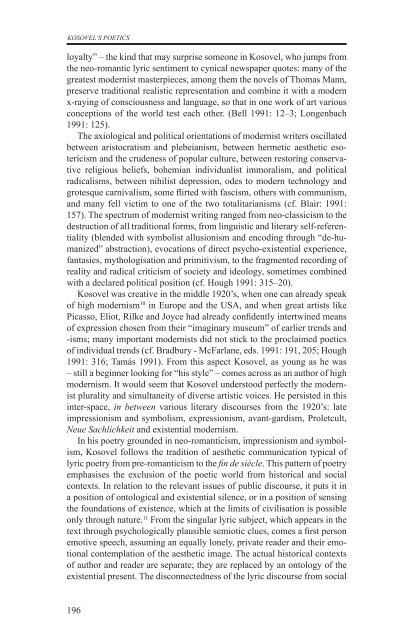razprave (pdf) - Društvo za primerjalno književnost - ZRC SAZU
razprave (pdf) - Društvo za primerjalno književnost - ZRC SAZU
razprave (pdf) - Društvo za primerjalno književnost - ZRC SAZU
- No tags were found...
Create successful ePaper yourself
Turn your PDF publications into a flip-book with our unique Google optimized e-Paper software.
KOSOVEL’s poeticsloyalty” – the kind that may surprise someone in Kosovel, who jumps fromthe neo-romantic lyric sentiment to cynical newspaper quotes: many of thegreatest modernist masterpieces, among them the novels of Thomas Mann,preserve traditional realistic representation and combine it with a modernx-raying of consciousness and language, so that in one work of art variousconceptions of the world test each other. (Bell 1991: 12–3; Longenbach1991: 125).The axiological and political orientations of modernist writers oscillatedbetween aristocratism and plebeianism, between hermetic aesthetic esotericismand the crudeness of popular culture, between restoring conservativereligious beliefs, bohemian individualist immoralism, and politicalradicalisms, between nihilist depression, odes to modern technology andgrotesque carnivalism, some flirted with fascism, others with communism,and many fell victim to one of the two totalitarianisms (cf. Blair: 1991:157). The spectrum of modernist writing ranged from neo-classicism to thedestruction of all traditional forms, from linguistic and literary self-referentiality(blended with symbolist allusionism and encoding through “de-humanized”abstraction), evocations of direct psycho-existential experience,fantasies, mythologisation and primitivism, to the fragmented recording ofreality and radical criticism of society and ideology, sometimes combinedwith a declared political position (cf. Hough 1991: 315–20).Kosovel was creative in the middle 1920’s, when one can already speakof high modernism 10 in Europe and the USA, and when great artists likePicasso, Eliot, Rilke and Joyce had already confidently intertwined meansof expression chosen from their “imaginary museum” of earlier trends and-isms; many important modernists did not stick to the proclaimed poeticsof individual trends (cf. Bradbury - McFarlane, eds. 1991: 191, 205; Hough1991: 316; Tamás 1991). From this aspect Kosovel, as young as he was– still a beginner looking for “his style” – comes across as an author of highmodernism. It would seem that Kosovel understood perfectly the modernistplurality and simultaneity of diverse artistic voices. He persisted in thisinter-space, in between various literary discourses from the 1920’s: lateimpressionism and symbolism, expressionism, avant-gardism, Proletcult,Neue Sachlichkeit and existential modernism.In his poetry grounded in neo-romanticism, impressionism and symbolism,Kosovel follows the tradition of aesthetic communication typical oflyric poetry from pre-romanticism to the fin de siècle. This pattern of poetryemphasises the exclusion of the poetic world from historical and socialcontexts. In relation to the relevant issues of public discourse, it puts it ina position of ontological and existential silence, or in a position of sensingthe foundations of existence, which at the limits of civilisation is possibleonly through nature. 11 From the singular lyric subject, which appears in thetext through psychologically plausible semiotic clues, comes a first personemotive speech, assuming an equally lonely, private reader and their emotionalcontemplation of the aesthetic image. The actual historical contextsof author and reader are separate; they are replaced by an ontology of theexistential present. The disconnectedness of the lyric discourse from social196
















